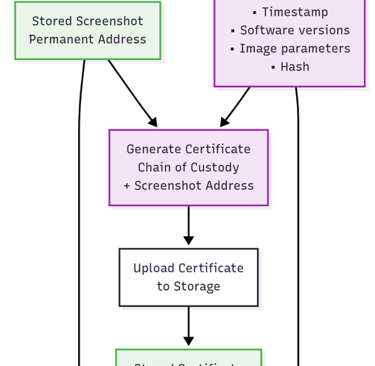We’re pre-launch and welcoming testers. Free MINT— email info@screenft.com
How ScreeNFT Works
The core feature of ScreeNFT is that users don't send their screenshots—they simply enter a URL, and our server captures the screenshot. This guarantees authenticity because every screenshot is taken by the same clean virtual machine under controlled conditions. Simultaneously, the system records comprehensive metadata about the capture process—timestamp, software versions, operating system, image parameters, hash, and other chain-of-custody data required for certification.
System Components
Screenshot Capture - Server-side image generation from any web URL using standardized software
Stored Screenshot - Permanently archived image in decentralized storage with unique address
Metadata Record - Complete chain-of-custody data (timestamp, software versions, image parameters, etc.)
Certificate - Authenticity document linking metadata to stored screenshot
NFT Token - Blockchain asset connecting all components with cryptographic ownership proof
Decentralized Storage - Permanent file storage on blockchain networks (IPFS or Arweave)
ScreeNFT Server - Protected virtual machine with screenshot capture software and blockchain integration
Ethereum Network - Blockchain infrastructure hosting smart contracts and NFT transactions
Process Overview
1. URL Submission - User enters the webpage URL they want to preserve
2. Screenshot Capture - Server captures screenshot using Chrome headless browser while recording process metadata
3. Decentralized Upload - Screenshot is stored in decentralized storage, receiving a permanent unique address
4. Certificate Creation - System generates authenticity certificate using collected metadata and storage address, also stored permanently
5. NFT Minting - NFT is created with links to both the stored screenshot and certificate, minted directly to user's Ethereum wallet
Security & Trust
Protection Against Counterfeiting - Security is guaranteed by our protected server environment and blockchain verification through a unique smart contract address. The smart contract includes cryptographic verification that prevents unauthorized NFT creation.
When minting an NFT, the smart contract requires a cryptographic signature from our server to prove the screenshot was processed through our verified system:
```solidity
function _verify(address user, string memory tokenURI, uint256 nonce, bytes memory signature) internal view returns (bool) {
bytes32 messageHash = keccak256(abi.encodePacked(user, tokenURI, nonce));
bytes32 ethSignedMessageHash = messageHash.toEthSignedMessageHash();
return ethSignedMessageHash.recover(signature) == owner();
}
```
This guarantees that every NFT from our smart contract was created on our server following the exact described process, with no editing or modification of the original screenshot.
Transparency - Users can preview their screenshot before deciding to mint, ensuring satisfaction with the captured content.
Decentralization & Ownership
ScreeNFT achieves complete decentralization—both technical and legal. From the moment of creation, the screenshot image and corresponding NFT belong entirely to the user who generates it.
Permanent Accessibility - Decentralized storage ensures eternal, unchangeable location of screenshots at their permanent addresses. Even if ScreeNFT service discontinues, all images, certificates, and NFTs remain intact—forever preserved in the blockchain.
True Ownership - While our server serves as the entry point for capture and minting, it doesn't control the stored data afterward. Your digital assets are yours permanently.
Current Status
ScreeNFT is currently in MVP stage with core functionality implemented. Enhanced features and expanded capabilities are outlined in our development roadmap.


